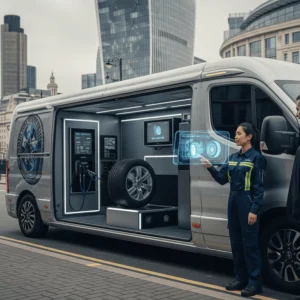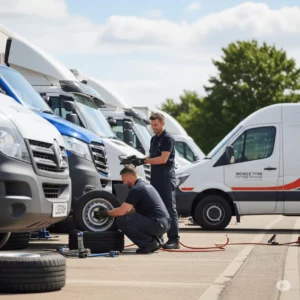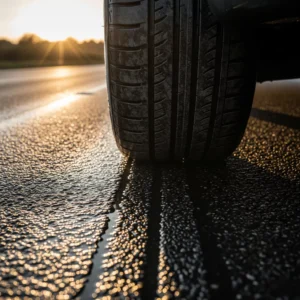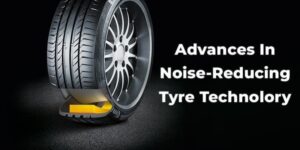Have you ever thought about why your car sometimes seems to “see” better than you?
There’s no magic there; that’s just modern science at work. In particular, it’s ADAS (Advanced Driver Assistance Systems) that help your car stay in its lane, avoid accidents, spot people, and even park itself.
In the UK, newer cars are starting to come with ADAS features like lane-keeping assist, adaptive cruise control, and emergency stopping. But there is a catch: for these systems to work right, they need to be perfectly calibrated. It only takes a small bump or a mobile tyre service to throw sensors out of line, which can compromise safety and accuracy.
With the fast development of car technology and the rising need for mobile tyre fitting 24 hours a day in places like Bristol, London and Manchester, more drivers are turning to mobile services to keep their cars in good shape. But a lot of people forget about an important part: regularly calibrating their ADAS.
What is ADAS and Why It’s Becoming Standard in UK Vehicles
Breaking Down ADAS (Advanced Driver Assistance Systems)
Advanced Driver Assistance Systems is what ADAS stands for, and it’s not just fancy car talk. If you want to drive better, smoother, and, let’s face it, a little more high-tech, these are the smart technologies in your car.
Some of the most common ADAS features you might already be using include:
Lane keep assist
warns or gently steers you back if you drift out of your lane.
Automatic emergency braking (AEB)
applies the brakes to avoid or reduce the impact of a collision.
Adaptive cruise control
keeps your vehicle a safe distance from the car ahead.
Real-life example: let’s say you’re driving along the M4 and your GPS suddenly pops up and takes your attention away from the road. Your car starts to veer off the road a little, but the lane departure warning system kicks in and slowly pulls you back into the lane. That’s ADAS doing its job, which is to keep crashes from happening.
It’s no longer just expensive cars either. Whichcham Research says that almost eighty percent of all new cars sold in the UK have at least one ADAS option. More and more, ADAS is being used on cars because the government wants better roads and higher safety standards.
Why Calibration Matters More Than Ever
ADAS is made up of a network of cameras, sensors, and radars placed all around your car, like on the bumpers, windows, front grille, and even the mirrors. These tiny parts constantly look at the road, process information in real time, and help your car decide what to do in a split second.
Is there a catch? A small change in any of these monitors can make the whole system not work right.
As an example:
- Changing your window might make the camera move a little.
- Getting new tires or having your car aligned can change the angle of radar sensors.
- A bump at a slow speed can move sensors out of place.
If that happens, your car might think you’re in the middle of the lane when you’re not, or even worse, it might not notice that a crash is coming up.
In a way, driving with ADAS sensors that aren’t lined up right is like having glasses that don’t fit right. It’s a little fuzzy, and you can’t tell how deep things are.
This is why ADAS tuning is so important. It makes sure that every sensor and camera is re-aligned exactly to the manufacturer’s specifications. This keeps your car’s high-tech systems working the way they’re supposed to.
When Should You Get Your ADAS Calibrated?
ADAS may seem like a feature that you can “set it and forget it,” but like any other part of your car, it needs regular maintenance and fine changes to work right. When sensors aren’t lined up right, they can give you wrong information or, even worse, they might not warn you at all when something is dangerous.
So when should drivers in the UK think about calibrating their ADAS?
Key Scenarios That Require Immediate Calibration
If any of the following apply to your vehicle, it’s time to book a calibration:
After a Windscreen Replacement
Your forward-facing camera is usually behind the windscreen. Even with the same model, replacing it can displace the camera sufficiently to affect ADAS accuracy.
Following Suspension or Steering Repairs
These components directly affect automobile geometry. Lane assist and adaptive cruise may malfunction if the alignment changes.
After a Collision (Even a Minor One)
A small bump can misalign sensors without noticeable damage. It takes a professional to calibrate ADAS.
When Getting a Tyre or Wheel Alignment
ADAS systems depend on wheel angle and position, therefore alignment changes might disrupt the system.
During Emergency Mobile Tyre Fitting or Roadside Tyre Change
More UK drivers are using 24-hour mobile tyre fitting and replacement services to keep going. However, changing tyres at a roadside may impact your vehicle's height or balance, especially if you use different ones. That may affect ADAS accuracy.
Real-World Risks of Ignoring ADAS Calibration
It may appear harmless to skip ADAS calibration, but it’s not. The precision of these systems determines their value. You endanger yourself, your passengers, and other drivers while they’re off. Let’s examine why you can’t ignore it.
Safety Compromises You Can’t Afford
Real-life example
One driver from the UK talked about what happened after their window was fixed. A few weeks later, they were driving through central Birmingham when a cyclist quickly swerved into their path. Their automatic emergency brake (AEB) did not work. The brakes were applied by hand just in time, which is good, but it was very close.
Another driver in Bristol said that their lane assist stopped working after they changed their tires. On the M5, the system didn’t help people stay in their lanes; instead, it kept leaning slightly, which almost caused a side-swipe accident before they noticed what was wrong.
The stats back it up
What Thatcham Research says is that ADAS failures, which usually happen because they aren’t calibrated properly, can make drivers overconfident, and they are now a bigger part of UK accident records. According to a report from the European Commission, if driver-assistance technology is set up properly, it could cut down on accidents by up to 20%.
But what if tuning isn’t done? That safety net goes away.
Legal and Insurance Consequences in the UK
ADAS calibration isn’t just about safety—it can also have legal and financial consequences.
MOT and Roadworthiness
Insurance Claims May Be Rejected
After windscreen replacements or repairs, many UK insurers enquire if ADAS was calibrated professionally. If not and you crash, your claim may be reduced or denied. If the car wasn’t maintained to manufacturer safety standards, the insurance could claim negligence.
Compliance with UK Law
Your car must always be roadworthy and safe under the Highway Code and UK car Safety Regulations. Your driving record and accident liability may be affected if your ADAS system was purposely mismatched.
How Regular ADAS Calibration Works (and What to Expect)
Think again about a difficult garage-only approach. Simple, efficient, and mobile ADAS calibration is possible today. UK drivers can now get calibration after replacing a windscreen or using a 24-hour mobile tyre fitting service.
Calibration Process Step-by-Step
Here’s what a typical professional ADAS calibration looks like:
Pre-Inspection
The mechanic checks your car for damage, makes sure the tires are in good shape, makes sure the car is properly aligned, and looks for any error codes. So, the testing will begin with a blank slate.
System Scan
With diagnostic tools, they check the onboard computer for ADAS problems, get rid of old codes, and get calibration procedures specific to the maker.
Sensor & Camera Alignment
Radar sensors, front-facing cameras, and sound sensors will all be changed based on the system. To make sure of pinpoint precision, laser measuring tools and special targets are often used.
Static vs Dynamic Calibration
For static calibration, which is done in a workshop with visual objects, there is no need to move.
The technician drives your car while the system is calibrated in real-world situations. This is called dynamic calibration, and it works best for features like lane keep assist or adaptive cruise control.
Final Test Drive & Validation
Once the system confirms everything is aligned, the technician takes a test drive to confirm that real-time data matches system expectations.
Pro Tip: some mobile tire services in the UK now do ADAS testing on-site along with changing tires. That means you can get an ADAS tune-up and a Rapid Mobile Tyre Fitting in the same visit. This is especially helpful after an emergency tyre change or alignment on the side of the road.
How Long Does It Take? Is It Expensive?
How long it takes to calibrate your ADAS system relies on the make and model of your car, as well as whether the calibration is static or dynamic. The whole process can usually be finished in 30 minutes to two hours. When using markers on-site, static calibration is usually faster. But, for dynamic calibration, you might need to take the car for a test drive on certain roads.
Most of the time, ADAS tuning in the UK costs between £150 and £300. The final price can change depending on how complicated your car’s system is. For example, luxury cars or cars with a lot of sensors and cams may cost more. But this cost isn’t that much when you think about what could happen if you drive with your ADAS not set correctly, like a higher risk of accidents or insurance claims being denied.
Is it really worth it? Of course. A properly adjusted system can help keep you safe on the road, make sure your car stays legal and up to date on its MOT, and keep your insurance claims eligible. It also raises the value of your car because buyers will be sure that it meets current safety standards.
More importantly, more and more mobile tyre fitting services in the UK that are open 24 hours a day are now giving ADAS recalibration on-site. You don’t have to miss work or have someone tow your car to a shop. You no longer have to leave your garage to get anything, from a quick mobile tire fitting to a full ADAS calibration, whether you have a flat tire or need new tires. It’s quick, easy, and designed for today’s busy workers.
Mobile ADAS Calibration in the UK – Is It Reliable?
As fast as car technology changes, UK drivers want more ease. As a result, mobile ADAS calibration services are becoming more popular. So the question is, can you really trust a mechanic who comes to your house instead of a dealership? Yes, as long as you pick the right service company.
The Rise of Mobile Calibration Services
Calibration used to require hours spent at a shop, but those days are over. Because diagnostic tools and portable gear have gotten better, many mobile techs in the UK can now do professional ADAS calibration at your home, office, or even on the side of the road. This is especially helpful when used with mobile tyre fitting 24 hours a day or emergency tyre changes on the side of the road.
There are more and more same-day mobile services that can do both tyre fitting and system recalibration. These services are available in Bristol, London, and smaller places across the UK. As an example, Mobile Tyre Fitting Bristol companies often do ADAS checks as part of their regular work. This helps you stay safe without having to go to a workshop.
It’s quick and easy, and it’s changing the way people in the UK think about maintaining their cars.
Mini Case Study
James from Bristol just got a new windscreen and called a mobile tyre and ADAS service company the same day. Within 90 minutes, the technician came to his house, put on two new front tires, re-calibrated his lane-keep assist and forward collision system, and gave him a written report. James said, “It was faster than I thought it would be and it saved me the trouble of making an appointment at the dealership.” On my test drive, the ADAS systems worked great.
People in the UK are starting to expect and earn that level of dependability.
Common Myths About ADAS Calibration – Debunked
Many UK drivers still don’t know when and why they need to calibrate their ADAS (Advanced Driver Assistance Systems), even though these systems are very important for keeping cars safe. Let’s bust some of the most popular road safety myths, so you know more and your car stays safer.
Only dealerships can do it
It’s only necessary after big accidents
Also not true. Precision is important for ADAS systems, and even small bumps or regular maintenance can knock sensors and cameras out of place. We often need to recalibrate because of the following:
- Replacement of windscreen
- Work on the suspension or steering
- Changes to the tires or balance
- Bumpy roads from curbs or holes
To put it simply, you don’t have to crash to need tuning. Your car’s safety systems might not work right if its “eyes” (sensors and cams) are a little off. This can be just as dangerous.
It’s just a money grab
We get it—no one wants to add something else to their car rental bill. But ADAS tuning isn’t just a trick. Making sure that life-saving tools like emergency braking, lane assist, and adaptive cruise control work when you need them most is a very important safety step.
Think about it this way: you wouldn’t skip an eye exam if you could barely see, right? Making sure your car can see the road clearly is the same thing as calibrating your ADAS.
Also, regular calibration could save you money by keeping your insurance valid, avoiding accidents, and making it easier to pass your MOT.
Conclusion
Advanced Driver Assistance Systems (ADAS) aren’t just fancy tech features; they’re tools that could save lives and depend on being accurate. From automatic emergency brakes to lane assist, these systems need to be calibrated correctly in order to work as they should.
In the end, this is what happened:
ADAS calibration every so often makes you and your car safer, helps it stay legal, and saves you money in the long run.
Being proactive about calibration means less shocks and better performance on the road, whether it’s after replacing the windscreen, the tires or even a small bump. You have to protect lives, including your own. It’s not just a matter of checking a box.
When you book a tyre service or use a mobile tyre fitting UK service, make sure you ask if they also do ADAS recalibration. Many now do, with services available 24 hours a day or the same day, so you don’t have to waste time or risk your safety.
Maintenance is the first step to being a smart driver. Keep yourself safe and in tune.
ADAS calibration makes sure that safety features in your car, like lane assist and emergency stopping, work correctly. It's important to do this after any work that might affect the sensors or camera, like replacing the tires or fixing the window.
It needs to be calibrated after certain fixes, like when you change tires, align the wheels, or have an accident, or at least once a year if you use the driver-assist features a lot.
Yes, many mobile tyre fitting services across the UK now offer on-site ADAS calibration for convenience and safety.
Your steering feels off, your lane assist doesn't work, or the warning lights on your dashboard act strangely. These are clues that your devices may not be lined up right.
It is up to your service provider and insurance company. Some cover it as part of fixes after an accident or longer warranties on cars. Always make sure before you book.




